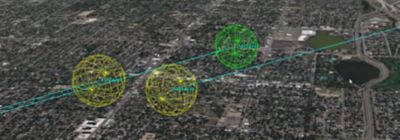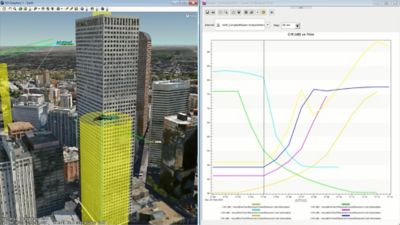-
-
학생용 무료 소프트웨어에 액세스하기
차세대 엔지니어에게 힘을 실어주는 Ansys
학생들은 세계적 수준의 시뮬레이션 소프트웨어를 무료로 이용할 수 있습니다.
-
지금 바로 Ansys에 연결하십시오!
미래를 설계하기
시뮬레이션이 다음 혁신을 어떻게 지원할 수 있는지 알아보려면 Ansys와 연결하십시오.
국가
무료 트라이얼
제품 및 서비스
학습하기
회사 정보
Back
제품 및 서비스

Advanced air mobility (AAM) promises a revolution in transport, taking cargo and passengers from gridlocked streets to the skies. It has the potential to greatly reduce transit time and help speed the transition to electrified vehicles. Startups and aerospace giants are working toward AAM, with over $22 billion invested since 2004, and a projected market size of over $50 billion by 2032. NASA’s vision is for hundreds of simultaneous operations over a single metropolitan area, including low-visibility operations and high-density routes.
However, there are key challenges to achieving the AAM vision. For example, the traffic volumes envisioned by AAM go well beyond the capacity of current airspace and air traffic control design, requiring entirely new and more automated approaches. AAM vehicles will rely on new technologies like autonomous systems and electric propulsion that call for clean-sheet designs of aircraft. These new aircraft types and the on-demand nature of AAM mean traditional airline business and operational models will not hold, again requiring new concepts for how to profitably and efficiently fly routes. A Booz Allen Hamilton study estimated the best-case current cost of AAM to be about $10 per passenger mile, against airline tickets at about $1 per passenger mile. Making AAM economically feasible will require extensive effort across domains to ensure the whole system can work together. Given the complexity of the AAM operational environment, modeling is essential to ensure every aspect of AAM is designed in the context of the web of interlocking systems.
NASA has identified key pillars to the AAM vision: airspace system design, individual aircraft management, airspace and fleet operations management, aircraft development, and community integration. Each of these pillars is complex, and AAM is a system of systems in which these coupled pillars must all work together. For example, community noise limits impact aircraft design and route planning, which in turn can increase costs or travel time, which then impacts the value AAM provides to those communities.
Airspace design depends upon many factors, such as vehicle autonomy levels and sensor capabilities. It also impacts fleet operations. Fleets must be operated safely, but airspace design must facilitate profitable operations. Vertiports must be located where they can serve the community, but a greater number of vertiports in denser areas complicates vehicle design constraints and airspace management.
Digital mission engineering (DME) software enables you to model these factors in a single, physically realistic environment. Within this environment, you can build up a complete operational model to visualize and analyze the interplay of different variables, optimizing their own designs and minimizing risk by exploring contingencies and trade space. DME is a key component in ensuring that vehicle design, regulatory efforts, and business models work together to enable safe and efficient AAM.
Using DME for a Mission Environment
Let’s take a quick look at how we can use DME to build up a mission environment. Using Ansys Systems Tool Kit (STK) digital mission engineering software, we can start by developing an aircraft. STK software enables you to define mission-relevant aspects of an aircraft, including basic parameters like lift, drag, and power consumption, as well as key subsystems such as communication and sensors. It even enables the import of noise models that can be tied to critical features like engine power output, for example.
Moving on from the aircraft development pillar, we can look at individual aircraft management. Once we have defined our aircraft, STK software enables you to plan trajectories for that aircraft that will account for the aircraft’s performance capabilities. In turn, it also provides metrics like total power consumed, duration of flight, and the ability for the aircraft to fly the desired trajectory. This can provide feedback for changes needed in an aircraft’s design, which can quickly be explored within the STK environment.

Evaluating route performance factors in Ansys Systems Tool Kit (STK) digital mission engineering software
Next, we can consider the community integration pillar, which specifically focuses on supporting infrastructure and noise tolerance. STK software enables you to define landing zones and the resulting requirements for steep or shallow approaches, based on market need. Importing noise models for different aircraft designs facilitates the assessment of how vertiport locations, planned trajectories, and aircraft design impact communities. If adjustments need to be made, you can explore the trade-offs between aircraft design and operational choices.

Monitoring emitted noise along a planned route in STK software
STK software can also integrate fleet operation concerns like efficient management and scalable operations. With the ability to assess total battery capacity and power consumption over different route choices, you can evaluate how route choice and charging strategies can impact scheduling, route capability, and profitability. STK software also enables you to include dozens of aircraft in their mission environments and track how well those aircraft can safely coordinate in crowded airspace under different assumptions. This enables you to ensure that aircraft design, individual routes, and community needs support safe operations and explore the impact of any of those requirements upon another.

Evaluating aircraft spacing and safety in STK software
Finally, we consider airspace design and implementation. With the DME environment in STK software, you can design corridors and explore the implications of corridor selection and different regulations on flight procedures such as spacing, altitude, and speed on all the factors described above. More importantly, the multiphysics environment in STK software can integrate a wide range of communication, navigation, and surveillance (CNS) systems. Managing hundreds of aircraft operating around urban canyons will require extensive CNS capabilities, and CNS performance may dynamically change during flight operations and interact with all the parameters described above. STK software enables you to define CNS systems and evaluate their connections over time under different design and operational assumptions to ensure sufficient communication coverage and navigation accuracy.

Analyzing communications signal strength while flying through an urban area in STK software
Learn How Digital Mission Engineering Supports Advanced Air Mobility
This is only a quick introduction to the vast parameter space that AAM depends on. Aircraft manufacturers, as well as fleet operators, urban planners, airspace regulators, CNS system vendors, and program managers, can benefit from AAM. DME’s ability to model the complexity of the operational space enables every player in AAM to understand how their decisions impact, and are impacted by, decisions in other domains to help the entire ecosystem become a reality.
Learn more about STK software and how it can help you.
The Advantage Blog
The Ansys Advantage blog, featuring contributions from Ansys and other technology experts, keeps you updated on how Ansys simulation is powering innovation that drives human advancement.


